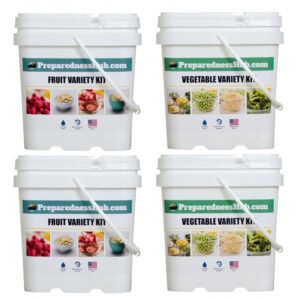
Preparing for an emergency should be top of mind for every family today, with the increase in natural disasters and other disasters. Many are trying to get ready, but do not know where to start. What should I store? How much should I pack? What are my essentials and what can I spare? The simplest launching point is a 72-hour survival kit. This series of articles is intended to help nudge you into action with everything you need to consider.
In the first of this four-part series, we discussed what scenarios to plan for: types of disasters, your geographical location and your family needs. If you’re just getting started, it might be best to review part one before moving forward.
Section 2 – Food, Water and Storage Techniques

When people think of emergency preparedness, the first thing they usually mention is foodand water. Everyone knows that in order to survive a disaster, you have to keep your body properly nourished and strong. It is one thing to be displaced from the comforts of your home; it is entirely another when you are hungry and thirsty as well!
Water is the number one short-term need in just about every emergency. The rule of thumb is a minimum of one gallon a day per adult for drinking and hygiene. But water is heavy ⎯ 8.3lbs per gallon, which makes 25lbs of water per person per day! That’s going to get heavy and bulky in a hurry, so consider your situation. If you are not likely to have access to water, bite the bullet and carry it along. But if water sources are nearby, water purification is a great solution. There are many ways to accomplish this, whether it is tablets, filters or sterilizing pens. Choose what works best for you and tuck it away in your kit, but always keep some amount of ready-to-go water in your kit. The bottom line is to be conscientious of the resources available to you in your area.
In a survival situation, you want food requiring little to no preparation. It needs to keep well, be lightweight, and be something all family members are willing to eat. Try not to feel guilty if you can’t include fresh fruits and veggies in your emergency diet—some foods just don’t store well, and you need to keep your energy up by getting sufficient calories that are as healthy as possible (Hopefully the disaster won’t last long enough for you to need your survival seeds!). Vitamin supplements store easily and are a good replacement. Don’t forget any special dietary needs of your family members, like baby food or allergies. Remember to rotate the foods in your kit ⎯ about every six months, unless it is packaged for long-term storage. If you forget, it should be fine, but as food gets older, it tends to lose both nutritive value and taste. Some of the best kinds of food for your kit are also popular snack foods (jerky, trail mix, nuts, granola bars, cookies, cereal, and hard candy), so you and your kids should enjoy rotating them out on a regular basis.
Of all the things you will keep in your 72-Hour Kit, food and water need the most care in how they are stored. The rule of thumb with all food storage is to keep it in a cool, dry, dark place; oftentimes, this means sticking it all in the basement. However, if a major threat in your area is earthquakes, this might not be the best place. The best kit in the world is useless at the bottom of a collapsed structure. A ground floor closet might be a letter solution, or maybe even in a backyard shed. If it does collapse, you have a lot less to dig through to find your supplies.
You are halfway there to having your 72-Hour Kit ready for any disaster. In the next installation of this four part series, we are going to help you assess your medical, hygiene and clothing needs.

 4-Pack Freeze-dried Vegetable & Fruit Kit - 300 Servings
4-Pack Freeze-dried Vegetable & Fruit Kit - 300 Servings